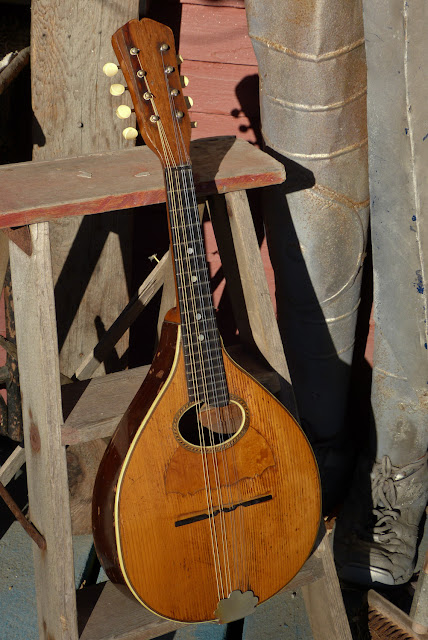1918 Vega Flatback Mandolin
I sold a similar mandolin a few years ago and have worked on one other of this same model in-between this one and that. Vegas are nice instruments with high-quality builds, nice materials, and great tone. Their flatback models tends towards clarity and sweetness but not a huge amount of volume. They're roughly in the same spectrum as a Martin flatback but, to my ears, sound fuller and more modern.
This is a customer's mandolin and -- oh my! -- what a poor little thing it is. The neck joint had entirely caved-in on it and there's not much to do about it once these get this bad as the joint is a "Spanish heel" -- meaning the neckblock and the neck are part of the same wood. To really reset the neck properly, the back needs to be slipped and there are some headaches involved monetarily for the owner in that case of action.
I have no qualms about doing a "good enough" job, however, and set-about fixing this up for the owner so that it'd play without getting into the grisly details. This included removing damaged bracing under the fretboard, installing a giant new Y-shaped brace that basically works as a "neckblock extension," figuring out a solution to compensate and lower the bridge to an absurdly-low height, and doing the usual fret level/dress and setup.
After work, it plays on-the-dot, is strung with a lighter 32w-9 "bowlback" gauge string set, and sounds great (listen above, if you doubt). I think it's definitely got some years left in it, too, despite its haggard state.
The neck is mahogany and it has a rosewood headstock veneer. The nut and fretboard are ebony.
Pearl dots and bar-stock frets are in the board. This has a 13 7/8" scale length which is unusual for the time -- most makers were still using a shorter 13" or 13 1/8" scale as opposed to the 13 7/8" scale which is Gibson's standard.
I took a cue from Italian bowlback mandolins I've seen in the past with the weird compensation technique on this extra-thin bridge.
The back and sides are mahogany and the back has a ton of old cracks -- some of which were repaired before and some of which I drop-filled and then cleated if I thought they'd spring open again. I also buttoned-up a few loose seams.
The tuners are replacements and probably from the 1920s.
In this shot you can actually see the shifting of the neck block. See that "point" below the heel where the binding juts out? That's where the neckblock moved forward past the sides.
My new, big, tight-grain-spruce "brace" is Y-shaped and snugs-up right against the neck block. The two arms of the Y fan out and support the compromised area of soundboard that was failing hard in the past. The original brace in this location was split in two places.
The serial number dates it to 1918, apparently.
















Comments